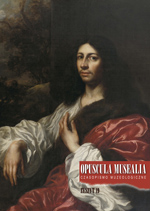Rentgenowska dyfraktometria proszkowa w badaniach zabytkowych obiektów. Nowe możliwości badawcze na Wydziale Chemii UJ
X-ray powder diffractometry in investigations of historic-objects. New possibilities of research at Faculty of Chemistry Jagiellonian University
Author(s): Marcin Oszajca, Wiesław Łasocha, Marta Grzesiak, Alicja Rafalska-ŁasochaSubject(s): Cultural history
Published by: Wydawnictwo Uniwersytetu Jagiellońskiego
Keywords: museums; university museums; university collections
Summary/Abstract: Powder diffraction techniques in studies of historical objects can be applied to the investigations of such substances as pigments, corrosion products of metals and other crystalline artistic materials. Unlike techniques such as X-ray fluorescence (XRF) and other methods of chemical analysis that provide information on elemental composition, XRPD enables the identification and differentiation of materials with similar or even identical chemical compositions. Shell and limestone, are chemically the same (calcium carbonate), but the atoms are arranged differently in each of them. It would be difficult to tell these materials apart using elemental analysis. Some techniques, however, such as X-ray diffraction (XRD), provide information on the way atoms are arranged in a given sample and thanks to this knowledge it is possible to detect which sample contain limestone an which contain shell. As other examples one can mention several pigments; e.g., two types of lead-tin yellow, Pb2SnO4 and PbSnO3 polymorphic modifications of TiO2, or different kinds of verdigris. Precise information on the substance used in an artwork is sometimes of great importance in the dating and authentication a work of art, and in studying the origin of historical materials and in characterization of the artist’s workshop. Moreover, a description of secondary changes in the phase composition enables the study of the signs and causes of damage produced by environmental conditions and is vital to the proper conservation of the object, whether through preventive measures or restorative treatment. X-ray diffraction analysis requires a very small sample (in micro-diffraction measurements, often much less than the size of a pinhead). Moreover an identification of the investigated materials can be performed with the use of already present reference powder diffraction data (PDF Files), which are prepared and distributed by the International Centre for Diffraction Data (Pennsylvania, USA). In this paper the results of the investigations of a green paint in the Gothic panel painting Resurrected Christ from Bodzentyn (Chrystus Zmartwychwstały z Bodzentyna are presented as an example of application of micro-diffraction analysis to study the pigments. Obtained results allowed identification of lead tin yellow type I (Pb2SnO4, PDF[24-0589]), hydrocerussite ((PbCO3)2Pb(OH)2, PDF[13-131]), malachite (Cu(OH)2CuCO3, PDF[56-0001]) and cynabar (HgS, PDF [42-1408]).
Journal: Opuscula Musealia
- Issue Year: 2011
- Issue No: 19
- Page Range: 25-36
- Page Count: 12
- Language: Polish

